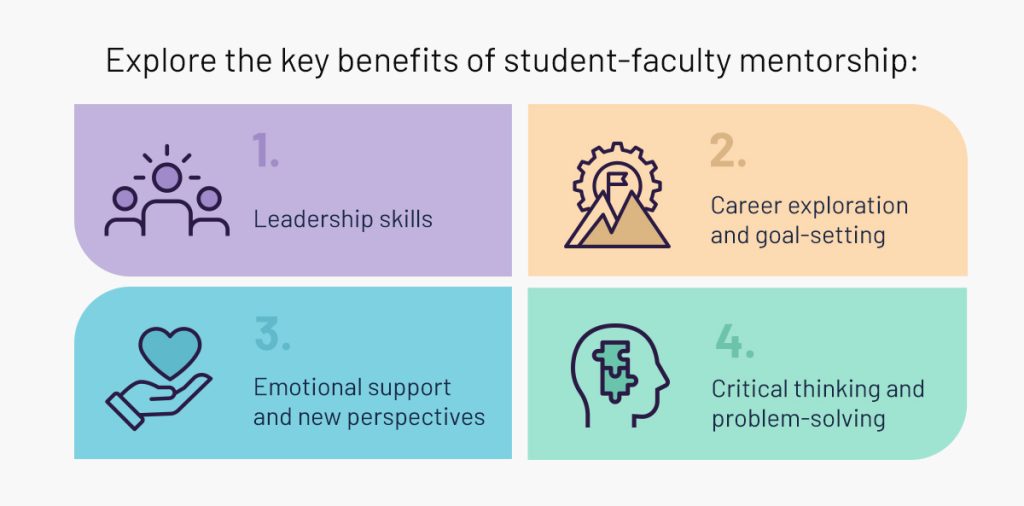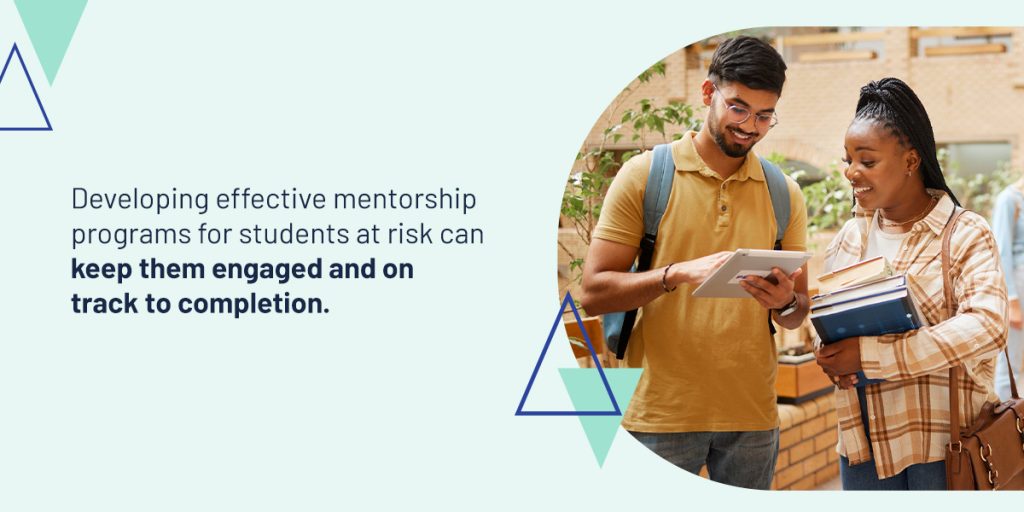




A strong student-faculty connection is integral to achieving academic success in and out of the classroom. Your teaching faculty is an incredible resource for your learners, and the relationships they establish can ultimately advance their careers.
Student-faculty relationships are important for several reasons. Students face many complex challenges in higher education, from adjusting to a new environment to meeting ever-increasing academic standards. Mentorship is a way institutions can facilitate intentional relationship building. It ultimately provides students with the support they need to navigate higher education and their subsequent careers.
Your institution can utilize different strategies to strengthen these relationships and inspire your students and teaching staff to lean on each other. Learn more about the value of connecting faculty and students below.
Your faculty has a direct impact on your higher education institution’s reputation, learning outcomes, and overall student experiences. They play an integral role in preparing learners for their lives and careers after graduation.
Implementing strategies to further develop student and faculty connections benefits colleges and universities in the following ways:
Strong relationships between students and teaching staff result in greater academic achievement and engagement. These connections help learners feel supported inside and outside of the classroom. When a student respects and feels comfortable with their instructor, they will be more likely to raise their hand in class, participate in meaningful discussions, stay motivated, and seek help when needed.
Faculty members who eagerly help students overcome academic challenges and create a welcoming environment for getting advice or feedback are highly valuable to your institution. They help remove the obstacles that keep students from getting the help and attention they need to succeed.
Positive student-faculty connections can also facilitate greater academic and research opportunities. With the right support and guidance, students can more easily navigate new concepts, exercise critical thinking, and boost problem-solving. These interactions between educators and learners greatly influence student retention and success.
The role of faculty and student connections goes far beyond the boundaries of campus. These relationships have a profound impact on the professional development of both students and their instructors.
Your teaching faculty have real-world experience and expertise in their fields, making them excellent mentors for individuals at the beginning of their careers. They understand what it takes to be successful and have meaningful connections within their respective industries.
Students who feel connected with their instructors can capitalize on this professional network to find job opportunities. Trusted faculty can also share letters of recommendation and references for learners after graduation.
In helping students take the next steps in their careers, faculty members can refine their communication and teaching skills to better serve the unique needs of different learners from diverse backgrounds.
Community is essential in higher education. The connections between your students and faculty play an important role in establishing a strong sense of belonging. Learners who develop meaningful relationships with their educators feel more supported and valued. They’ll also be more likely to participate in extracurricular activities with professors that they respect and feel comfortable with.
With the increased emphasis on mental health in higher education over the last decade, instructors are responsible for fostering open communication and advising struggling students. This support contributes to a strong sense of community that is vital for student and faculty retention.
Healthy student-faculty connections also enhance collaboration for research initiatives, community engagement activities, and other academic projects. These relationships make students feel like they can get the advice, support, and feedback needed to succeed. They are integral to establishing an inclusive environment where everyone’s contribution is valuable.
Mentoring provides benefits for students and mentors alike. Explore the key benefits of student-faculty mentorship :

One of the principal benefits of faculty-student mentoring is that it develops leadership skills. Together, mentors and mentees can practice communication and decision-making. Mentors also encourage students to speak up, navigate challenging conversations, and grow their confidence.
Mentorship allows students to experiment with their leadership skills and learn from errors with a dedicated person who has made similar mistakes.
Many students find the future abstract and uncertain. Mentors put their minds at ease, allowing students to explore their interests in a safe space. They assist in setting realistic goals, discussing potential career paths, and building professional networks. Mentors can also take advantage of the collaboration to achieve their own career goals, such as furthering research work.
With mentorship, students can set specific, measurable, achievable, relevant, and time-bound (SMART) goals. They have practical steps to break down their long-term aspirations into manageable steps, which builds confidence.
Mentorship often results in trusted friendships. It’s normal for students to encounter challenges on their academic journeys. Mentors are a stable presence that students can turn to when they need support.
Mentorship goes both ways. Students get nonjudgmental guidance, support, and practical growth strategies. Mentors sharpen and expand their skills while enjoying the fulfillment of enhancing the lives of their mentees. Each party introduces the other to new perspectives, broadening horizons.
Mentorship and the resulting student-faculty connection fosters an environment where critical thinking can flourish. Mentors help students develop problem-solving skills and teach them how to approach challenges constructively. When students feel comfortable engaging with their mentors, they’ll ask questions, challenge ideas, and explore complex concepts.
The mentorship dynamic also cultivates a lifelong learning mindset. Students learn to articulate their thoughts and acceptably defend their viewpoints, while mentors benefit from new ideas and perspectives. These skills translate into professional settings and serve students and faculty throughout their careers.
Colleges and universities can take steps to bridge the gap between learners and instructors. The following are useful tips for enhancing these important connections at your institution:
Open communication is the first step in connecting faculty and students. Learners need to know how to reach their instructors outside of class. Encourage your teaching staff to have regular office hours and share the best ways (by email or phone, for example) and times to get in touch with questions or concerns.
Office hours are a great way for students and educators to get time one-on-one. They offer a time and place to discuss complicated concepts from class and deepen relationships. Students who actively engage with professors outside of class can enrich their academic experiences and gain more confidence.
When faculty and students feel comfortable openly expressing their thoughts and feedback, it creates a supportive and trusting environment. Learners will be more engaged and eager to participate in a space where they feel their voice is heard and valued.
Open lines of communication also allow your teaching staff and students to better understand one another, which is integral for building long-term relationships.
Another tip for strengthening the bond between your institution’s faculty and students is to emphasize the value of personalized interactions. Students can easily fly under the radar in today’s academic landscape, especially in virtual classes. By taking the time to get to know their students on a personal level, your instructors can understand their needs on a deeper level and tailor their teaching approaches accordingly.
Personalization and adaptive learning approaches are increasingly commonplace in higher education because they are more engaging and impactful. Receiving individualized attention or feedback can enhance the academic experience and make students feel as though their institution values and supports them.
Every learner is different. In catering to each student’s unique strengths and weaknesses, your faculty can demonstrate a commitment to inclusivity and excellence.
Tailored support and personalized attention ultimately enhance the connection between your faculty members and students.
A proper mentorship program is a fantastic way to bring faculty and students closer together. Higher education institutions can facilitate these initiatives in several different ways.
The first is assigning each learner a specific instructor to meet with periodically. During these meetings, instructors and students will review current coursework and create a strategic plan for the future. These types of meetings tend to be academic, but they can also serve as a safe space for students to navigate challenges, make informed decisions and set goals with the help of an experienced faculty member.
Mentorship programs can also be less structured, allowing students and professors to create professional relationships organically. Learners can inquire about industry-specific questions, and their mentor can be a great resource when stepping into the working world.
These mentor-mentee relationships can also inspire more individuals to connect on a deeper level with your teaching faculty. They are also an incredible tool for fostering a culture of continuous improvement where students feel inspired to find new ways to improve with the guidance and support of a trusted faculty member.
Your institution can also strengthen faculty and student connections by implementing feedback mechanisms, such as:
Both students and faculty members benefit from receiving ongoing feedback, allowing them to connect over ways to improve performance and strive toward excellence.
When your higher education institution’s faculty has the tools they need to succeed, they can refine their methodologies, expand their understanding of new teaching concepts, and ultimately improve student experiences. By offering your teaching staff professional development opportunities, you allow them to gain new skills and expertise needed to advance in their careers and become better instructors for your institution.
Some popular examples of professional development opportunities include training, conferences, workshops, and online learning platforms. These events and programs can help your teaching staff:
When you equip your faculty with impactful professional learning and development opportunities, the students at your institution benefit directly from this growth.
Another way for your higher education institution to facilitate strong and meaningful connections between faculty and students is through recognition. Everyone enjoys feeling like their hard work and expertise are valuable to their workplace, and your teaching staff is no exception.
Shed light on their accomplishments, particularly in terms of how they give back to their students. By highlighting the instructors who go above and beyond to get to know their students and guide them in their academic journeys, you can encourage more of your faculty members to immerse themselves in their classes and establish professional relationships with learners.
Encourage your teaching staff to recognize their students, too. Showing appreciation for their dedication to learning and becoming better students can be highly motivating for learners, providing positive reinforcement for their diligence and effort.
In addition to spotlighting the successes, your faculty can also benefit from recognizing when students are struggling with their coursework. Early intervention can help a student get back on the right track for academic success. Your instructors and learners can work together to find strategies to help, making students feel supported and closer to their professors.
Faculty appreciation initiatives can also be a helpful tool in bringing together your faculty and students. Urge your institution’s students to recognize the instructors making a difference in their lives. Create a culture of recognition and appreciation across campus.
Your college or university can encourage its students and teaching staff to enhance their relationships through collaborative academic projects or community initiatives. These may include research endeavors, charitable causes, or curriculum-related work that goes beyond the classroom.
These types of projects incorporate elements of mentorship, allowing your students to learn from instructors in real-world experiences. Your teaching faculty can share their expertise, help guide important decision-making, and become an invaluable resource for students.
Working on these initiatives allows your instructors to demonstrate professional collaboration and teamwork, helping students gain valuable working experience. Participating in extracurricular projects is an attractive quality to include in job applications, and it gives students an opportunity to connect with professors in a deeper way, making them an excellent reference for future employers.
If your higher education institution is interested in new ways to enhance faculty-student connections, social events may be the perfect idea. Whether your college or university hosts these meetups virtually or in person, your students and teaching staff can connect on common interests that extend past the course curriculum and work. Some ideas for these types of events include:
Your higher education institution can encourage faculty and students to come together and establish meaningful connections by emphasizing the importance of active participation across every facet of campus life.
When your teaching staff engages with students in extracurricular activities or clubs, it creates a strong sense of community. Encourage your instructors to use campus amenities and immerse themselves in their student life.
Promote active participation in your student body. Incentivize them to attend campus events, including theater, sports, speakers, and seminars. These events offer a valuable opportunity for students and faculty to have informal interactions that break down barriers, enhance communication, and establish a sense of camaraderie.
One tactic every faculty member can utilize to get to know their students better is small group instruction or activities. Dividing their classes into groups of less than 10 people allows instructors to connect with learners on a much deeper level and get to know their unique strengths and weaknesses as students.
Smaller groups typically mean more time for individualized attention and care from the professor. Your instructors and students can benefit from direct communication and insight while also having the support of a few other students to bounce ideas around and further validate their experiences.

Mentorship is even more powerful when you target the right students. Developing effective mentorship programs for students at risk can keep them engaged and on track to completion. The best way to identify these students is through data. You can start with course registration, analyzing which students have not signed up for courses. Other indicators of at-risk students include:
The solutions from Watermark help institutions harness the power of data-backed decision-making to enhance the educational experience for faculty and students alike. Our Educational Impact Suite helps your university or college leverage automation to supercharge institutional efficiency and serve your stakeholders better.
With Watermark Student Success, you can monitor each learner’s journey and increase engagement to support boosted retention, graduation, and job placement rates. When paired with Watermark Faculty Success, your institution can also foster instructor development and achievement.
Are you interested in learning more? Request a demo to see higher education’s leading software suite in action today.





























































































































































































































































































































































































